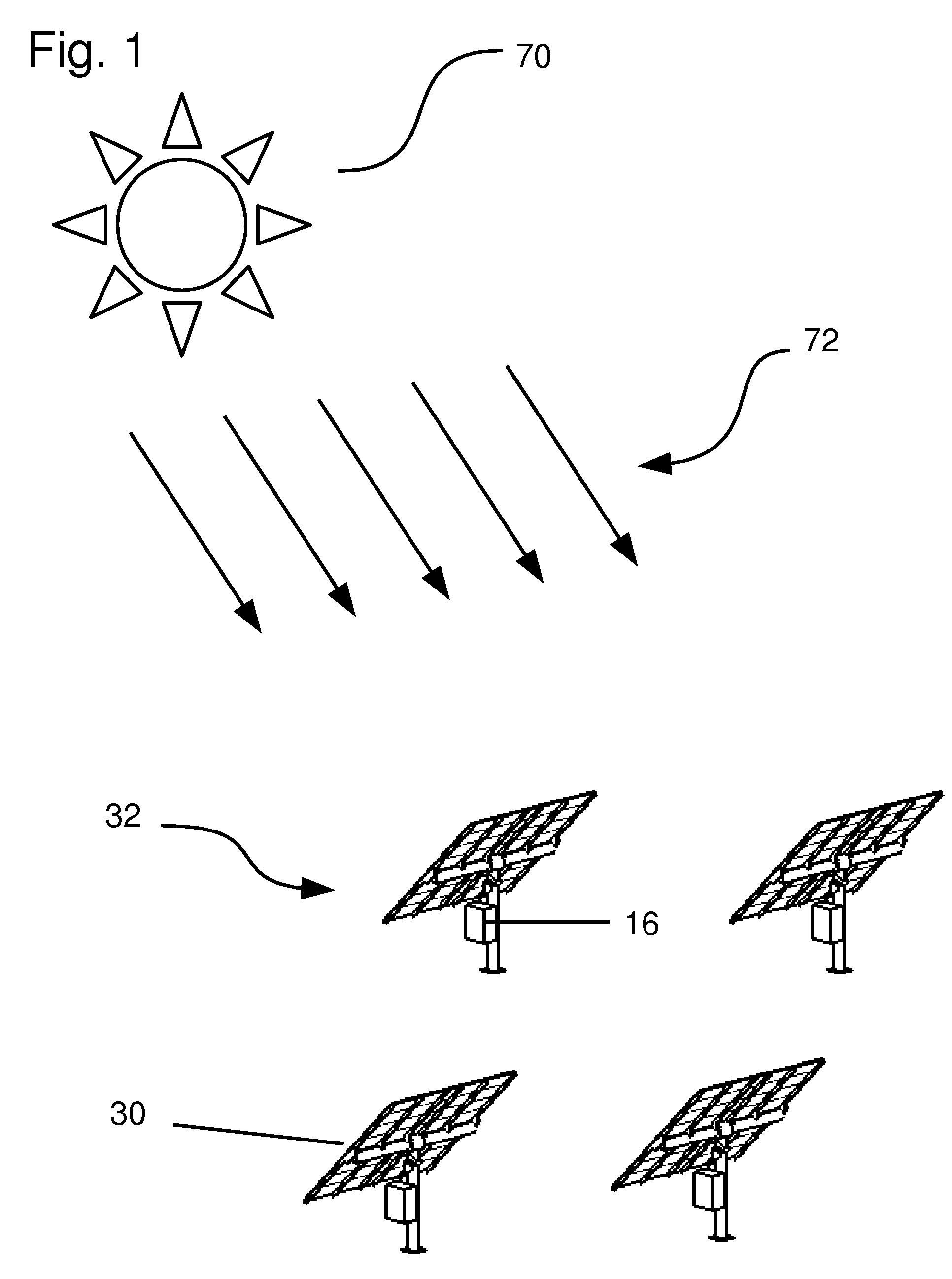Wireless mesh networking of solar tracking devices
a solar tracking and wire mesh technology, applied in the field of solar tracking, can solve the problems of increasing the cost and cumbersome task of operating and monitoring control systems, the burden of companies and municipalities, and the inability to meet the needs of the market,
- Summary
- Abstract
- Description
- Claims
- Application Information
AI Technical Summary
Benefits of technology
Problems solved by technology
Method used
Image
Examples
first embodiment
[0032]Referring to FIG. 2, solar tracking device 32 is shown, on which is mounted a tracking controller 16. Tracking controller 16 is responsible for computing both the position of sun 70 and the desired orientation of tracking payload 30 based on variables such as date, time, latitude, and longitude. Based on the results of these calculations, tracking controller 16 can control actuators of tracking device 32 (possibly using sensors of tracking device 32 for this task). In this first embodiment, tracking payload 30 is shown as an array of solar panels.
[0033]Referring to FIG. 3, the data communication paths available in the first embodiment are shown. A host computer 10 communicates via communication channel 12 to host gateway 58. Host gateway 58 in turn communicates with network manager 14. Finally, network manager 14 communicates with tracking controller 16 via a wireless mesh communications network 18. In this first embodiment, base station 56 houses both host gateway 58 and netw...
second embodiment
[0040]Referring to FIG. 8, a representative view of the wireless mesh communications network of this invention is shown. In this embodiment, one of tracking controller 16 provides network manager 14 and host gateway 58.
[0041]Referring to FIG. 9, components of the second embodiment are schematically illustrated. Identical to FIG. 5, communication channel 12 represents the path from host computer 10 to host gateway 58. Network manager 14 and host gateway 58 have identical functions here as in FIG. 5. However, in this second embodiment, base station 56 is not necessary, as tracking device 32′ provides network manager 14 and host gateway 58.
first embodiment (figs.1 , 2 , 3 , 4 , 5 , 6 , 7)
[0042]Operation—First Embodiment (FIGS. 1, 2, 3, 4, 5, 6, 7)
[0043]The apparatus for wireless mesh networking of solar tracking devices 32 of this invention is used in this embodiment to improve aspects of a site that contains a plurality of solar tracking devices 32. Tracking device 32 in this embodiment of the invention comprises senors, actuators, mechanisms, and controls suitable for orienting tracking payload 30 in two axes with respect to sun 70. In this embodiment, tracking payload 30 comprises flat plate solar panels that point directly at sun 70 when this is possible given the mechanism of tracking device 32. This is a common configuration of solar tracking device 32. However, there are many other configurations of tracking device 32 that can be used in other embodiments of this invention. For instance, single axis tracking devices 32 are common that orient tracking payload 30 (again flat plat solar panels) in one axis with respect to sun 70. This type of tracking device 32 ...
PUM
 Login to View More
Login to View More Abstract
Description
Claims
Application Information
 Login to View More
Login to View More - R&D
- Intellectual Property
- Life Sciences
- Materials
- Tech Scout
- Unparalleled Data Quality
- Higher Quality Content
- 60% Fewer Hallucinations
Browse by: Latest US Patents, China's latest patents, Technical Efficacy Thesaurus, Application Domain, Technology Topic, Popular Technical Reports.
© 2025 PatSnap. All rights reserved.Legal|Privacy policy|Modern Slavery Act Transparency Statement|Sitemap|About US| Contact US: help@patsnap.com



